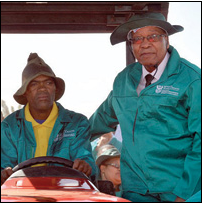There is hope for those who go to bed hungry, with government allocating R2 billion to the Integrated Food Production Initiative, which aims to put food on the tables of South Africans.
 The funds have been set aside to support Fetsa Tlala (End Hunger) programme, an initiative President Jacob Zuma officially launched in Batlharos, outside Kuruman in the Northern Cape, recently.
The funds have been set aside to support Fetsa Tlala (End Hunger) programme, an initiative President Jacob Zuma officially launched in Batlharos, outside Kuruman in the Northern Cape, recently.
The programme, aimed at producing enough food to meet the population’s needs, is an approach by government, involving a number of sectors, to deal with the problem of food insecurity.
“We are making R2 billion available for this programme as part of comprehensive support to farmers and for distribution to provinces. The initiative intends to put one million hectares of land under production of maize, beans and potatoes,” President Zuma said.
Government will help small-scale and smallholder producers put at least one million hectares of arable land across the country under production by 2019.
The President said through Fetsa Tlala, government also wanted to shift perceptions about agriculture and farming in general.
He said the impression that agriculture was not as important as other sectors was wrong.
Agriculture is a key priority for government, as it forms part of the six job drivers identified in the New Growth Path.
The other five are mining, tourism, the green economy, manufacturing and infrastructure development.
According to President Zuma, this demonstrates the seriousness government has attached to agriculture for food security, job creation and economic development.
He said through Fetsa Tlala, all underutilised agricultural land must be put under production.
“We are encouraging people to go back to farming. We are encouraging every household to establish a food garden. We want to see women’s cooperatives and community groupings focusing on vegetable production, livestock or chickens to earn a living and fight hunger and poverty.”
The Fetsa Tlala initiative is already active in the Eastern Cape and Limpopo while plans are underway to extend it to other provinces.
Food insecurity
President Zuma - who also visited the Manyeding Agricultural Cooperative project, which is playing a role in fighting hunger and food insecurity in villages east of Kuruman - was encouraged that the overall food insecurity figure was declining due to government programmes.
The cooperative, which has a total of 159 beneficiaries from Manyeding and surrounds, is situated on a 137-hectare land. It produces organic vegetables such as potatoes, tomatoes, spinach, green beans, cabbage and pumpkin.
Since the start of the cooperative in 2010, many jobs have been created for the locals. The cooperative supplies fresh produce to Pick n Pay, Boxer and Spar supermarkets.
However, the President noted that families still lived in poverty and the country remained a net importer of food, instead of being a major food producer.
Maximising land
According to the President, a significant amount of land still lies bare, especially in rural areas and some acquired through land reform.
He said smallholder farmers, communities and households would be assisted through the provision of mechanical equipment and distribution of production inputs and technical services.
Much of the worst poverty is concentrated in the former homelands. The homelands, which accounted for 13 per cent of the country’s land, were home to half of the black population in South Africa before 1994.
These areas are still characterised by low incomes and high rates of infant mortality, malnutrition and illiteracy.
“These areas have remained extremely poor and underdeveloped, and are heavily dependent on remittances from workers in industrial South Africa,” President Zuma said.
He said South African agriculture continued to be characterised by a racially skewed distribution of assets, support services, market penetration, infrastructure and income.
“Some 36 000 large-scale farmers control over 86 million hectares of farmland, while 1.4 million black farmers have access to about 14 million hectares of farmland,” he pointed out.
The President was confident that by working together South Africans could fight hunger.
“Achieving food security is in our hands, all of us. We must get back to the land and start working to produce food,” he stressed.



 Facebook
Facebook Twitter
Twitter WhatsApp
WhatsApp